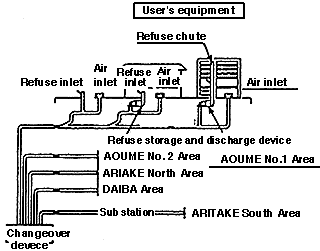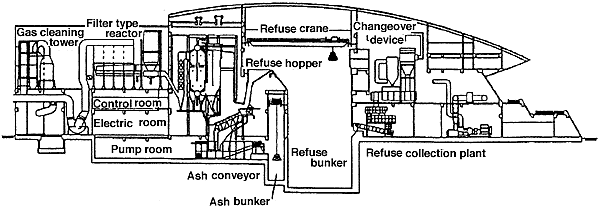Waste Treatment Technology in JAPAN
Drying, Incineration and Melting
Fig. 1 TOKYO RINKAI INCINERATION PLANT
(2) Providing a uniform supply of combustion air to prevent local high
temperature combustion.
(3) The use of well heat resistant stokers.
(4) The use of stoker cooler by means of steam spray.
2) Preventive measures for harmful substances
(2) For dioxin, advanced combustion control is introduced to reduce its
generation, as well as bag filters to remove it with a high efficiency
(90% or more ).
(3) For NOx, proper selection of non-catalytic and catalytic de-NOx systems.
(2) Automatic start/stop system in which start and stop operations requiring
complicated operation are automatically performed according to a
predetermined furnace temperature curve for controlled increase and
decrease of the furnace temperature.
(3) Fuzzy control system in which the operating rules empirically obtained by
skilled operating personnel are incorporated into the automated system by
using a fuzzy control method with quantitative representation of
ambiguities.
(4) Failure diagnosis system which enables the user to run this system stably
with safe and ease by taking the appropriate corrective action if a failure
occurs .
(5) Run simulation system which enables the user to train the operator by using
the simulator.
(6) Network system available which enables the user to have knowledge control
of the failure diagnosis system and to give technical support from a remote
station. ( Fig.2 )
Fig.2 DIAGNOSIS & NAVIGATION SYSTEM
1. General
This is the latest Stoker Type Refuse Incineration Equipment designed to permit complete incineration of complicate nature of wastes and its features include the controlled treatment of various harmful materials such as dioxins, the high efficiency energy recovery, and the use of various automated systems. Fig. 1 shows a conceptual diagram of the Incineration Plant combined with a Refuse Vacuum Sealed Conveyance System.


2. Characteristics
1) Measures for high calorie refuse.
(1) The use of the furnace body with higher cooling effect to have higher
temperature combustion capability.
These measures enables this system to cope with high calorie refuse (3,000 to 3,500 kcal/kg).
(1) For HCl, SOx, dust and mercury, a dry type bag filter system having the
same level of removal efficiency as the conventional wet system is provided
in which the temperature at the inlet of bag filter is reduced to the order
of 42 150tC and a cake filtering mechanism with salked lime and special
dose is used.
3) Systems for automatic control
(1) Automatic combustion system in which constant steam flow control, constant
refuse throughput control, and CO concentration control are now available.
System operation form
Substitution of knowledge control and other functions can be obtained by the network service system.
